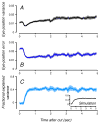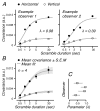Temporal eye movement strategies during naturalistic viewing
- PMID: 22262911
- PMCID: PMC3273487
- DOI: 10.1167/12.1.16
Temporal eye movement strategies during naturalistic viewing
Abstract
The deployment of eye movements to complex spatiotemporal stimuli likely involves a variety of cognitive factors. However, eye movements to movies are surprisingly reliable both within and across observers. We exploited and manipulated that reliability to characterize observers' temporal viewing strategies while they viewed naturalistic movies. Introducing cuts and scrambling the temporal order of the resulting clips systematically changed eye movement reliability. We developed a computational model that exhibited this behavior and provided an excellent fit to the measured eye movement reliability. The model assumed that observers searched for, found, and tracked a point of interest and that this process reset when there was a cut. The model did not require that eye movements depend on temporal context in any other way, and it managed to describe eye movements consistently across different observers and two movie sequences. Thus, we found no evidence for the integration of information over long time scales (greater than a second). The results are consistent with the idea that observers employ a simple tracking strategy even while viewing complex, engaging naturalistic stimuli.
Figures







References
-
- Andrews TJ, Coppola DM. Idiosyncratic characteristics of saccadic eye movements when viewing different visual environments. Vision Research. 1999;39:2947–2953. - PubMed
-
- Angelone BL, Levin DT, Simons DJ. The relationship between change detection and recognition of centrally attended objects in motion pictures. Perception. 2003;32:947–962. - PubMed
-
- Birmingham E, Bischof WF, Kingstone A. Gaze selection in complex social scenes. Visual Cognition. 2008;16:341–355.
-
- Bordwell D, Thompson K. Film art: an introduction. 6. New York: Mc Graw Hill; 2001.
Publication types
MeSH terms
Grants and funding
LinkOut - more resources
Full Text Sources
Other Literature Sources

